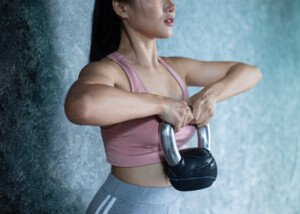What exercises should you avoid if you have a bad AC joint?
Perhaps you badly injured it and it never fully recovered, and you’ve made efforts to work around it when in the gym.
The acromioclavicular joint is formed by the cap of the shoulder and the collarbone or clavicle.
The AC joint is held together by ligaments. It’s certainly possible to strain these ligaments from heavy lifting.
You may think that the only way to injure a ligament is to subject it to torsion or twisting, such as in the case of a sprained ankle from rolling on it.
But AC joint ligaments can also be subjected to microtears by being overloaded with too much resistance.
If this is paired with overstretching, such as a “deep” range of motion during a lift, the damage will be even worse.
Five of the Worst Strength Training Exercises for a Crummy AC Joint
These are in no particular order. You’ll want to avoid these if your AC joint tends to hurt after workouts.
The pain will usually be accompanied by limited range of motion, which may be due to the discomfort.
Overhead motions will hurt. So will lifting something out in front of yourself or just even raising the arm out in front without any resistance.
1 Upright Row

Upright row. Freepik.com, jcomp
“This puts excessive compressive force through the front of the shoulder and requires a lot of strength in the muscles located in the back of the shoulder,” says Dr. Megan McLain, PT, DPT, cofounder of Intuitive Choice Physical Therapy & Wellness in Atlanta, GA.
“Bringing the elbows up in line with the shoulder will not be a comfortable position for someone who has had a prior AC joint injury, because this puts excess force here.”
The upright row also gets bad marks for its potential to harm the rotator cuff tendons.
There are so many other, safer ways to build shoulder strength and sculpt or enlarge the shoulder muscles.
2 Bar and Bench Dip
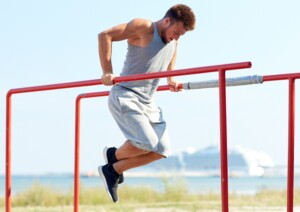
Bar dip. Shutterstock/Syda Productions
“These are typically performed with the hands located behind or in line with the trunk,” says Dr. McLain.
“This position puts excess upward strain through the AC joint and the front of the shoulder.”
In addition, range of motion can contribute. Dipping brings the potential for going too far down, or too deep, stretching the joint beyond what it’s comfortable with.
However, even if you make a point of keeping your upper arms parallel to the floor or even slightly above parallel, the motion of dipping will still place unnatural load onto the AC joint.
In fact, think of it this way: There is no motion in the natural world, among humans, that mimics dipping.
Hunter-gatherers don’t perform dips to survive. Quite frankly, the dip is an unnatural joint motion – though let’s face it, bar dips with a 45 pound plate hanging from one’s waist look impressive, and this “show move” does a good job of building size in the triceps.
3 Behind Neck Overhead Press

Behind neck press. Shutterstock/Serghei Starus
Dr. McLain explains that this is “similar to triceps dips, due to the positioning of the hands behind the body.
“This setup puts extra strain through the AC joint.
“A better alternative would be to use a light weight and perform the overhead press from in front of the body.
“Depending on the stage of recovery, overhead presses may not be appropriate.”
The overhead press behind the neck, needless to say, is not a motion found in nature among humans, no matter how primitive their mode of living.
When people need to hoist something above head level, it’s always in front of themselves – such as placing baggage in a compartment above an airline seat, or putting something on a high shelf.
When’s the last time you had to push a weighted object upward, from behind your neck?
The only time you’ve ever done this was during a strength training workout.
The risk to your AC joint is not worth it, being that there are numerous other ways to work the shoulders.
4 Curse of the Flye
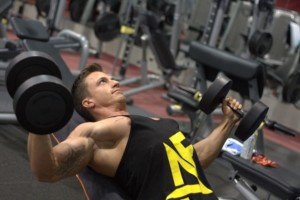
Dumbbell flye, though usually, it’s done with less bending at the elbows.
“Due to the position where the elbows are in line with the shoulder, this is a difficult position for the AC joint,” says Dr. McLain.
“This becomes especially problematic if you allow the elbows to drop behind the body and below the line of the shoulder.”
Flyes aren’t a prime way to build chest size or strength, simply because the nature of the movement doesn’t allow use of weight loads nearly as high as when doing a standard dumbbell chest press.
Because the motion involves the arms out at one’s sides, with the dumbbell at their ends, this means a very long resistance arm.
This is why a person who can whip out regular presses with 50-pound dumbbells can’t come close to using these same weights for flyes.
Flyes with light weights may be suitable for warming up or warming down, but this exercise is bad for the AC joint when done with heavy weight or even with moderate weight if the elbows drop below the shoulder line.
5 Wide Grip Bench Press

Wide grip bench press. Shutterstock/Serghei Starus
“A wider grip is going to put excess strain through the front of the shoulder and the AC joint,” says Dr. McLain.
“In order to lessen the strain, complete a bench press with a narrower grip, and do not allow the elbows to drop below the level of the body.”
The wide grip is done by those training for powerlifting competitions, because it shortens the range of motion.
It tricks the body into thinking one has shorter arms. With a wide grip, the elbows aren’t bent as much when the bar is at the chest, vs. if the grip were narrower. This allows for more weight to be lifted.
However, the tradeoff is the stress on the AC joint. Furthermore, a wide grip isn’t too friendly with the rotator cuff, either.
If you have sturdy and never-injured AC joints, then wide gripping may be great for you.
But if you have a tweaky, finicky AC joint, forget it.
Replacement Exercises for the Above
Instead of the upright row, do front dumbbell, cable or plate raises, and/or lateral raises with dumbbells or cables.
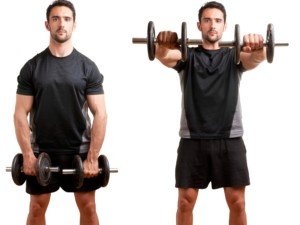
Shutterstock/ruigsantos
Substitutes for dips can be a dumbbell raise from behind the neck — if that doesn’t aggravate your rotator cuff — or triceps push/press-downs with cable machines, using either a rope or handles.

Shutterstock/GlebSStock
Another good triceps exercise is standing or sitting at a Smith machine and, with a narrow grip, pushing the bar upward.
Other triceps exercises to consider include the close-grip pushup, ball press-up, lying press holding dumbbells against each other with a neutral grip, and a seated dipping machine.

Shutterstock, Zeljko Matic
Instead of behind neck presses, do them in front, and you can also press dumbbells or kettlebells overhead.
Plate presses are another option, as well as shoulder press machines (weight stack or plate loading).
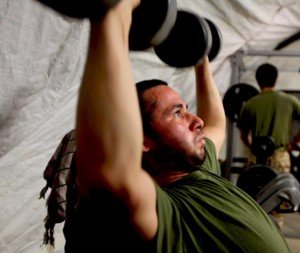
Flyes and wide grip benching can be replaced with standard or narrower grip benching, the incline bench press, the dumbbell press and chest machines.
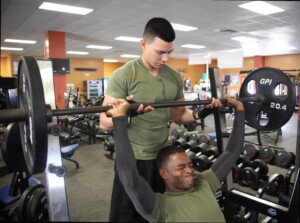
 Dr. Megan McLain, PT, DPT, puts her clients first while providing one-on-one in-home care. With physical therapy and health coaching services, Dr. McLain addresses all aspects such as physical barriers, mindset, accountability and knowledge that may be impacting the client’s experience.
Dr. Megan McLain, PT, DPT, puts her clients first while providing one-on-one in-home care. With physical therapy and health coaching services, Dr. McLain addresses all aspects such as physical barriers, mindset, accountability and knowledge that may be impacting the client’s experience.
 Lorra Garrick is a former personal trainer certified by the American Council on Exercise. At Bally Total Fitness she trained clients of all ages for fat loss, muscle building, fitness and improved health.
Lorra Garrick is a former personal trainer certified by the American Council on Exercise. At Bally Total Fitness she trained clients of all ages for fat loss, muscle building, fitness and improved health.
.



